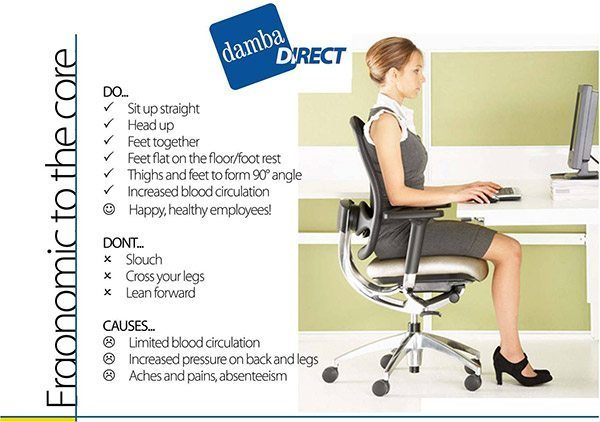The spine is perfectly designed for normal standing posture. It consists of a series of curves called the Cervical, Thoracic and Lumbar. These three curves make up a natural ‘S’ curve, which we associate with good posture. It has been estimated that these three curves lead to an increase in strength, which is ten times greater than that of a straight column.
- The cervical curve (neck) has seven small vertebrae, which have good movement but are not designed to transmit large amounts of weight or force.
- The thoracic curve carries an intermediate amount of weight or force and is a relatively inflexible part of the spine. Its mobility is affected by the rib cage, to which it is attached.
- The lumbar spine is built for strength and designed to absorb forces, transmit weight and is quite mobile in forward and back bending.
Sitting Correctly
Its not just having the right chair, its knowing how to sit correctly!
You may have just purchased the most ergonomic chair on the market, but still have those same problem areas of sore back, sore legs, sore neck.
Have you purchased ergonomic task seating for your staff, but still seem to have complaints from them? Well, it sounds like they need to be trained on how to sit on the chairs!
At Damba Direct, we offer your staff free training on how to sit and how to use your chair for the best results. We tell you what all the levers are for, how to adjust them to suit your body.
People Sit In Poor Posture for 3 Reasons
- Forward slip – If we sit for 10 minutes or more, the muscles in our lower back get tired and we slide forward on our seats. As our pelvis moves forward our back curves into the ‘C’ shape of poor posture putting pressure on the spine and over time creating muscle fatigue.
- Inadequate Lumbar Support – Many office chairs have insufficient lumbar support because they fail to support the lower back which forces the muscles to work harder to support the spine and lower back pain soon results.
- Unstable forward tilt – Tilting the chair forward creates a comfortable sitting position for reading and writing; however, many people fail to use their forward tilt because in this position they start to slide forward in their chairs.

